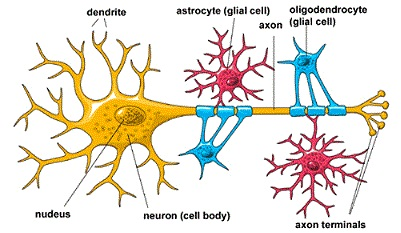Glial cells
The Glial cells, sometimes known as neuroglia or simply glia, are non-neuronal cells which maintain homeostasis form myelin, and give support and protection for neurons in the brain, and for neurons in another parts of the nervous system like in the autonomic nervous system.
As the Greek name imply, glia are commonly termed as the glue of the nervous system; though, this is not fully correct.The Neuroscience presently specifies four main functions of glial cells: to surround the neurons and hold them in place, to supply the nutrients and oxygen to neurons, to insulate one neuron from the other, and to destroy pathogens and remove dead neurons. For over a century, it was supposed that they did not play any role in neurotransmission. That idea is now dishonored; they do modulate neurotransmission, though the mechanisms are not yet well understood.

Some glial cells function mainly as the physical support for neurons. The others regulate the internal environment of the brain, specially the fluid surrounding neurons and their synapses, & nutrify neurons. During early embryogenesis, glial cells direct the migration of the neurons and produce molecules which modify the growth of axons and dendrites. Current research points that glial cells of the hippocampus and cerebellum participate in synaptic transmission, control the clearance of neurotransmitters from the synaptic cleft, and release the gliotransmitters like ATP that modulate synaptic function.
Types of Glial cell
The Glial cells outnumber neurons approximately four-fold in the cerebral cortex, but in the other regions (example, cerebellum) glia are greatly outnumbered. Overall the glia/neuron ratio in the human brain is thought to be close to 1. They mediate functions that support neurons. Numerous distinct populations of glia are familiar: astrocytes, oligodendrocytes involving Schwann cells, and microglia.